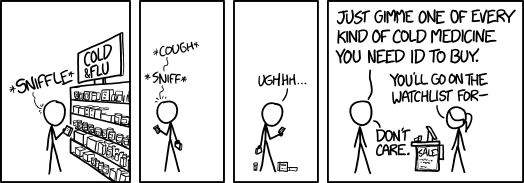 Are you cheap? Lazy? Vaguely and perhaps unjustifiably paranoid about slathering your body with chemicals on a daily basis? Then perhaps you’d like to join the “no-poo movement”? It is more than just a hair-care revolution—it’s also the perfect way to trick others into using the term “poo”! But from here on out I’m just going to call it quitting shampoo, because it doesn’t actually involve laxatives, and it’s less a “movement” than a “beauty tip.”
Are you cheap? Lazy? Vaguely and perhaps unjustifiably paranoid about slathering your body with chemicals on a daily basis? Then perhaps you’d like to join the “no-poo movement”? It is more than just a hair-care revolution—it’s also the perfect way to trick others into using the term “poo”! But from here on out I’m just going to call it quitting shampoo, because it doesn’t actually involve laxatives, and it’s less a “movement” than a “beauty tip.”
Why would you want to quit shampoo? Well, there are plenty of people who will tell you that the chemicals in shampoo like methylisothiazolinone and diethanolamine can give you terrifying health problems like nerve damage and Alzheimer’s disease. But those people are probably not correct; while it might not be good to literally bathe in that stuff, the small amounts in shampoo likely will not hurt you. What is true is that certain chemicals in shampoo, especially foaming agents like sodium lauryl sulfate (SLS, for short), can irritate your scalp and hair, as well as the skin that your hair touches, meaning you and your hair don’t look as healthy as you could.
So, let’s review: quitting shampoo will clear up your complexion and make your hair look awesome, plus it will save you time and money. Also it’s better for the environment to use fewer plastic bottles and wash less poison down the drain. And there’s I guess a tiny chance it will also save you from some combination of cancer and let’s go with…epilepsy. Ready to give it a try?
Here’s how you do it:
Step 1: Switch from shampoo to baking soda and vinegar
-To make your new “shampoo,” slowly add water to baking soda until it’s just slightly gooey. You can make as much or as little as you like to start. The exact proportions aren’t really that important, but it’s best to err on the side of adding too little water. Once you’ve got it to a consistency you like, store it one of those little travel bottles or a jar and keep it handy in your shower.
-Next, make the “conditioner.” Add 1–2 tablespoons of apple cider vinegar—NOT white vinegar—to about a cup of water. Again, the measurements don’t have to be precise, but in this case, it’s better to have to little vinegar than too much. Store this in your shower as well.
-Now it’s time to implement your new hair-washing routine. First, rub the baking soda all over your wet hair, particularly into the roots. Scrub it in there the best you can, let it sit for one minute, and then rinse your hair thoroughly. Next, pour the vinegar conditioner on your hair, rub it in, this time paying more attention to the ends of your hair than the roots, and then rinse.
-Use the baking soda and vinegar in place of shampoo and conditioner for at least two weeks. I promise, your head will not become a science-fair volcano. (Note: I’ve heard from no less authoritative a source than The Internet that if your hair ends up too frizzy, you should use less baking soda, and if it’s too greasy, cut down on vinegar. This has never been a problem for me, so I don’t know for certain, but I’m sure you can trust The Internet.)
Step 2: Switch from baking soda and vinegar to just water
At this point, all you need do is massage your scalp under running water in the shower. You can gradually taper off the baking soda or just go cold turkey.
Your hair will become quite greasy, but only for a little while. For me, Peak Grease was reached on Day 4. On that day, I was obliged to go to my boyfriend’s band’s performance at a gallery show featuring paintings of naked men. I wore a hat. But so okay: shampoo strips your hair of its natural oils, which makes your scalp overproduce more oil to compensate. After you stop shampooing, it takes some time for your scalp to recalibrate and reduce oil production. But don’t worry, after about a week without shampoo, your hair will get closer to reaching its natural balance, and you’ll no longer look like you’re in the throes of puberty.
After the first week, you’ll still have a little more waiting it out to do. Your hair will continue to be greasier than usual for four or five weeks. If you have bangs, ask yourself this: is it a cute, sassy style to have grease all over your forehead for a month and get a bad breakout and have sticky little shreds of hair instead of bangs? If your answer is no, then pin your bangs back for the time being. Aside from that, your hair might look a little dirty, but probably no one else will notice.
One of the biggest sacrifices you’ll have to make during this whole process is that you can’t use any mousse, gel, or other styling product during this stage, because they’ll mess up the whole “hair finding its natural balance of oils” deal. If you’re hella stressing, you can put a tiny bit of baking soda along your part and comb it into your hair to absorb excess grease, but seriously, after the first week, no one will think you look weird unless you’re just a weird-looking person generally.
The main thing you want to do is brush brush brush your hair—it’ll scrape some of the grease out from your roots. I assume this is why old-style ladies of yore did the “brush your hair 100 strokes” thing; it was probably the easiest way to keep your hair clean before bathing was invented. Don’t actually brush your hair 100 strokes, though. You’ll give yourself split ends and look mildly to moderately OCD. (Note: Do clean clean clean your brush. Sorry if you look OCD on this one, but it’s mandatory to get rid of all the grease. Maybe do it in private? I don’t know. I believe in you.)
Step 3: Add the baking soda and vinegar back in, once a week
After you’ve gotten through the waiting game, you’ll be looking lovely and your hair will be perfect and soft. Now all you need to maintain that healthy glow is to wash once a week with baking soda and vinegar. That should be enough to keep your hair clean now that it isn’t constantly overcompensating. Depending on your hair, you might want to bump it up to twice a week or down to once every ten days.
If you still need styling products, go for SLS-free stuff from brands like Aubrey Organics or Suncoat. No commercial products are going to be completely “natural” (whatever that even means), but the fewer polysyllabic chemical names on the label, the better. For hippie bonus points, make your own hair products at home from ingredients like flaxseed and lemon juice. (Google has plenty of recipes.) There’s a good chance you won’t even need any product at all, though. The only thing I use is a dryer with a finger diffuser, and my hair usually stays curly or at least wavy until I get in the shower again.
See it doesn’t seem so bad, does it? Just think how good you’ll feel about all the money you’ve saved, all the chemicals you’ve avoided — not to mention how you single-handedly rescued Mother Nature. So go on and get rid of poo, in your hair and in your life!
See also: What I’ve Learned From Three Years Without Shampoo
Lauren O’Neal grew up near Berkeley, California, but didn’t become a dirty hippie until after moving to Texas.







 John Hollensbury, enclosed the alley next to his house to keep out wagons, loitering youths, and other miscreants. The house isn’t really a “house” with its own walls and structural system—it’s an enclosed alley with a roof and a front door, only about 7 feet wide and 25 feet deep.
John Hollensbury, enclosed the alley next to his house to keep out wagons, loitering youths, and other miscreants. The house isn’t really a “house” with its own walls and structural system—it’s an enclosed alley with a roof and a front door, only about 7 feet wide and 25 feet deep. The Story: Again, there are multiple explanations here. One involves the owners of the larger property selling off a narrow strip of land between their house and the street. They made the mistake of selling it to a carpenter, who started building on the site, got into a fight with the former landowners, and went and built a ten-foot-wide, 54-foot-long house in the space, completely blocking the larger house’s side view of anything but wall. Another story says that the larger plot of land belonged to a father with two sons, one estranged—the father gave the estranged son the smaller plot of land, and you all know how this ends.
The Story: Again, there are multiple explanations here. One involves the owners of the larger property selling off a narrow strip of land between their house and the street. They made the mistake of selling it to a carpenter, who started building on the site, got into a fight with the former landowners, and went and built a ten-foot-wide, 54-foot-long house in the space, completely blocking the larger house’s side view of anything but wall. Another story says that the larger plot of land belonged to a father with two sons, one estranged—the father gave the estranged son the smaller plot of land, and you all know how this ends. owned some lots along 82nd Street and wanted to fill them with apartment buildings. His land extended nearly to Lexington Avenue and he wanted to buy up the remaining strip of land to complete the block. The owner of the land, a Mr. Richardson, wanted much more for the property than McQuade/Sarner wanted to pay for it, so McQuade/Sarner said screw you and your crappy land, I didn’t want it anyway, and built his apartments so they overlooked the strip of land toward Lexington Avenue, clearly thinking that they would be able to enjoy the view without any buildings popping up in the five-foot-wide space. You see where this is going, right?
owned some lots along 82nd Street and wanted to fill them with apartment buildings. His land extended nearly to Lexington Avenue and he wanted to buy up the remaining strip of land to complete the block. The owner of the land, a Mr. Richardson, wanted much more for the property than McQuade/Sarner wanted to pay for it, so McQuade/Sarner said screw you and your crappy land, I didn’t want it anyway, and built his apartments so they overlooked the strip of land toward Lexington Avenue, clearly thinking that they would be able to enjoy the view without any buildings popping up in the five-foot-wide space. You see where this is going, right? The Story: So you’ve got two brothers. One brother goes to fight in the Civil War, and the other stays home and builds a house on their recently-deceased father’s property, leaving a strip of land for his soldier brother that was certainly too narrow to build on. Soldier brother comes back, gets mad, builds a house—just over 10 feet wide at the widest point—immediately on top of the brother’s house, cutting that side of the house off from sunlight, fresh air, and anything that isn’t a very angry brother going “THIS IS YOUR FAULT, YOU JACKASS.” Presumably.
The Story: So you’ve got two brothers. One brother goes to fight in the Civil War, and the other stays home and builds a house on their recently-deceased father’s property, leaving a strip of land for his soldier brother that was certainly too narrow to build on. Soldier brother comes back, gets mad, builds a house—just over 10 feet wide at the widest point—immediately on top of the brother’s house, cutting that side of the house off from sunlight, fresh air, and anything that isn’t a very angry brother going “THIS IS YOUR FAULT, YOU JACKASS.” Presumably.






























